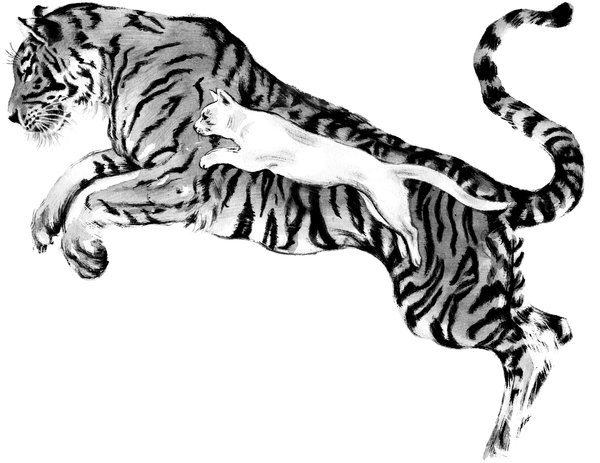(单词翻译:单击)
DAVIS, Calif. — IT’S commonplace to call our cats “pets.” But anyone sharing a cat’s household can tell you that, much as we might like to choose when they eat in the morning, or when they come inside for the night, cats are only partly domesticated.
加利福尼亚州戴维斯——我们的猫通常被称为“宠物”。但任何一个跟猫共同生活的人都会告诉你,我们虽然很想决定它们早上进食或者晚上进屋的时间,但它们并没有被完全驯化。

The likely ancestors of the domestic dog date from more than 30,000 years ago. But domestic cats’ forebears join us in the skeletal record only about 9,500 years ago. This difference fits our intuition about their comparative degrees of domestication: Dogs want to be “man’s best friend”; cats, not so much.
家犬的祖先可能出现于3万多年以前。但骨骼化石记录表明,家猫的祖先迟至大约9500年前才进入人类社会。这一差距与我们对两种动物驯化程度差异的直观感受是一致的:狗想成为“人类最好的朋友”,猫则不然。
Fossils are handy snapshots of the past, but a genomic sequence is a time machine, enabling scientists to run evolutionary history backward. The initial sequence of the domestic cat was completed in 2007, but a recent study to which I contributed compared the genomes of the domestic cat and the wildcat (Felis silvestris) and sheds new light on the last 10,000 years of feline adaptations.
如果说化石是现成的历史缩影,那基因组序列就是一台时光机,让科学家得以追溯进化的历程。对家猫基因的初步测序是在2007年完成的。但最近,我参与的一项研究比较了家猫和野猫(Felis silvestris)的基因组,可以让人们更好地了解猫在过去1万年间适应环境的过程。
Domestic cats are not just wildcats that tolerate humans in exchange for regular meals. They have smaller skulls in relation to their bodies compared with wildcats, and are known to congregate in colonies. But in comparison with dogs, cats have a narrower range of variation in size and form.
家猫不仅仅是为了规律饮食,而勉强和人类呆在一起的野猫。与野猫相比,它们头骨与躯干的比例更小;而且众所周知,它们会集群而居。但和狗相比,不同种类的猫在大小和外形上的差异不是太大。
Wesley C. Warren, an author of the study, notes that domestic cats have excellent hunting skills, like their wild ancestors. This, too, supports the notion that cats are only semi-domesticated.
研究报告的执笔者之一韦斯利·C·沃伦(Wesley C. Warren)指出,家猫和它们生活在野外的祖先一样,有出色的狩猎技能。这就为家猫只是半驯化动物的观点提供了支撑。
Comparing the genomes of the wildcat and the domestic cat added much to what we had known. Michael J. Montague, the lead author, told me he’d anticipated that the two genomes would be very similar, but our study found a specific set of differences in genes involved in neuron development. This brain adaptation may explain why domestic cats are docile.
比较野猫和家猫的基因组,让我们的既有认知有了极大的拓展。研究报告的第一作者迈克尔·J·蒙塔古(Michael J. Montague)告诉我,他曾经预计两者的基因组会非常相似,但我们在研究中发现了一组涉及神经元发育的特定基因。这种大脑的适应,或许可以解释为什么家猫比较温顺。
Scientists have long observed that domesticated species exhibit a suite of strikingly similar traits, from floppy ears to smaller brains, than those of their wild ancestors. Domestication may select for a few similar traits encoded by genetic changes (like smaller brains), but these may produce what we assume are secondary effects (like floppy ears).
科学家早就发现,家养物种有着一系列极为相似的特征,如软趴趴的耳朵,以及比野生祖先小的大脑。驯化过程可能会选择一些由基因差异决定的相似特征(如较小的大脑),但这些基因可能又会带来我们眼中的次生效应(如软趴趴的耳朵)。
Once they were living among us, cats didn’t need to think so much to stay alive; nor did they need such large jaws after we started feeding them our processed scraps. Hence smaller skulls. The same dynamic holds for dogs: Wolves beat dogs in general intelligence tests.
自从和人类生活在一起,猫要生存下去就不需要思考那么多了;以人类的残羹剩饭为食,它们也不再需要大大的下巴了。因此,它们的头骨变小了。狗也是如此:狼在智力测试中的表现通常好于狗。
By examining patterns in our animals’ genomes, we’ve confirmed that the same sets of genes seem to be targeted again and again in evolution. As far back as Charles Darwin, domestic animals in particular have yielded insights about evolution because we know what sorts of selection pressures they were subject to. After all, it was us they were primarily adapting to.
我们通过观察家养动物的基因组图谱确定,在进化过程中,某些特定的基因一再成为选择的目标。早在查尔斯·达尔文(Charles Darwin)的时代,对于家养动物的研究,就帮助拓展了人类对进化过程的认识,因为我们很清楚它们面临着怎样的选择压力。毕竟,它们主要是在适应人类。
Which brings us to the genome of one critical tame animal: ourselves, humans. The Nobel Prize-winning zoologist Konrad Z. Lorenz once suggested that humans were subject to the same dynamics of domestication. Our brain and body sizes peaked during the end of the last ice age, and declined with the spread of agriculture.
作为一种重要的驯化动物,人类自身的基因组也是进化过程的产物。获得过诺贝尔奖的动物学家康拉德·Z·洛伦茨(Konrad Z. Lorenz)曾表示,人类也受制于同样的驯化机制。我们大脑和躯干的尺寸在最后一个冰川时代结束时达到最高点,继而随着农耕的推广逐渐变小。
Instead of poring over the meager fossil record, we can survey patterns of variation across tens of thousands of living individuals. Genomics now provides evidence that humans have been subject to a great deal of natural selection over the past 10,000 years. A beautiful example is the ancestors of Tibetans’ absorption of small portions of the genome of ancient human relatives adapted for living at high altitude.
我们不必去钻研匮乏的化石记录,而是可以研究千千万万活人的基因差异。目前,基因组学方面的证据表明,人类在过去1万年里一直受到了自然选择的极大影响。一个有力的例子是,西藏人的祖先汲取了少量与其有亲缘关系的适应高海拔生存的古人类的基因。
Our cultural flexibility and creativity since the end of the ice age have not freed humans from evolutionary forces, but have opened up novel and startling paths. Thinking of domestication as an evolutionary process that occurs through “artificial” selection creates a false dichotomy of nurture and nature that plays into a conceit of human exceptionalism. In fact, the idea that we are apart from nature, that it is ours to tame and exploit, is an outmoded approach.
最后一个冰川时代结束以来,人类的文化适应性和创造力并没让我们摆脱进化力量的影响,而是为这种力量开辟了令人吃惊的新路径。把驯化当成由“人工”选择推动的进化过程,让人们错误地把自然过程和驯化过程分割开来,由此催生出自负的人类例外论。认为人类与自然相分离、人类要驯化和开发自然,其实是一种过时的思维。
A more useful interpretation is that over the past 10,000 years, humans fashioned their own ecosystem. We were part of a natural process that altered the landscape. In that light, we can think of the domestic cat as an ecological response to the emergence of parasites (rodents attracted by early Neolithic granaries). The same forces that reshaped the genomes of our domesticates also reshaped ours.
一个更有帮助的解释是,在过去的1万年里,人类塑造了自己的生态系统。我们是改造自然面貌的自然过程中的一部分。鉴于此,我们可以这样看:在新石器时代早期,人类储藏谷物的地方就招来了老鼠,而家猫的出现,则是生态系统对这些吃白食的啮齿动物做出的反应。重塑了家养动物基因组的力量,也重塑了我们自己的基因组。
No longer roving in small bands subsisting on game and unprocessed plants, we settled down in villages, harvesting the same crops year after year. For millenniums, peasants fed on what we might today term porridge, of various types. Our teeth became smaller — indeed, both dogs and humans show evidence of adaptation to starchy diets.
当我们不再组成小群体四处游荡,不再依靠猎物和未经烹调的植物为生,而是在村庄里安定下来,年复一年地收获着同样的作物。数千年来,农民都在食用我们今天称为粥的各种饭食。于是我们的牙齿变小了——的确,狗和人类都表现出了适应淀粉类食物的迹象。
Just as the fur of our mammalian domesticates, freed from the constraint of needing to fade into the landscape, became a riot of diverse colors, human pigmentation started to change and many populations became light-skinned. With a cheek-by-jowl existence, humans and their animals began sharing diseases, remolding the immunity of whole populations, but leaving those who did not experience this co-evolution untouched and vulnerable. Possibly, some pathogens incubated in cats, like Toxoplasma gondii, may even alter human behavior.
经过人类驯化的哺乳动物的皮毛,在不需要适应环境的颜色后,变化成了各种各样的颜色。与此相同,人类的色素沉着开始发生变化,许多人群变成了浅肤色。在紧密共处的过程中,人类和他们的动物开始患同样的疾病,从而重塑了整个种族的免疫系统,但那些未曾经历这种共同进化历程的种族,却没有受到影响,因而容易患病。弓形虫等在猫体内孕育的病原体,甚至可能会改变人类行为。
Many of us conceive of our relationship to our pets as analogous to that between a parent and child. But the natural history tells a more pragmatic tale. Cats emerged in the context of profound ecological changes to the post-ice-age landscape wrought by humans.
许多人都认为,我们与宠物的关系就如同父母与孩子的关系。但是,自然史讲述了一个更加实际的故事。在冰川时代过后的地貌上,人类造就了显著的生态变化,猫就是在这种背景下出现的。
We were the authors of those changes, but in the process of telling that story, we became protagonists within it. One of the essential steps in knowing ourselves, and seeing where we are going, is to look around and take note of how we’ve reshaped those nearest to us, and they us.
我们是这些变化的作者,但在讲述这个故事的时候,我们也成了它的主角。在了解我们自身、观察我们将走向何方的过程中,一个关键步骤是环顾四周,研究我们怎样重塑了离我们最近的那些生物,以及它们如何塑造了我们。


